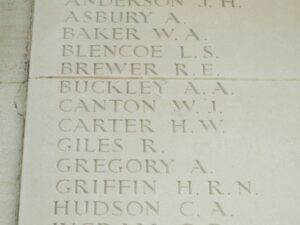The village of Bosherston is located in a lovely position in Pembrokeshire, to the south of the county town of Pembroke. The village Church, which is dedicated to St Michael and All Angel’s, dates from Norman times and was restored by the Cawdor family in 1855. Inside the church are three memorial plaques, one which commemorates the parishioners who fell during the First World War; another which commemorates all of the parishioners who served during the Second World War; and a third which commemorates a local coastguard man who was killed during the Second World War. This page commemorates all of these.
The Great War, 1914-1918
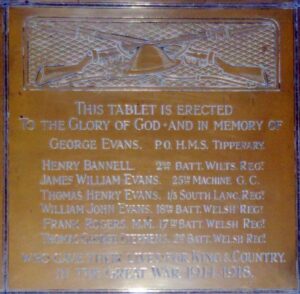
Henry John Bannell, Corporal, 7006, Wiltshire Regiment. Henry was born in Dogdean, Salisbury in 1884, the son of William and Sarah Elizabeth Bannell. He married Sarah Jane Johns whilst working at Bosherston prior to the war, and the couple resided at New Sarum, Wiltshire. Henry enlisted at Salisbury into the 2nd Battalion, the Wiltshire Regiment, which formed part of 21 Brigade, 7th Division based at Lyndhurst. The Division landed at Zeebrugge on 7 October, 1914, but the Port was already falling to the Germans, and so they were sent to Ypres, where they fought in the First Battle of Ypres. They stayed in the Northern part of the Western Front throughout 1915, fighting at the Battles of Neuve Chapelle, Aubers Ridge, Festubert, Givenchy and the Battle of Loos, before the Brigade was transferred to the 30th Division on 19 December 1915. The first major engagement for the Division was at the opening of the Battle of the Somme, and Henry was killed in action on the Somme on 8 July 1916, aged 31, during the Battle of Albert. He is buried at Bernafay Wood British Cemetery, Montauban, France. in Grave G. 45.
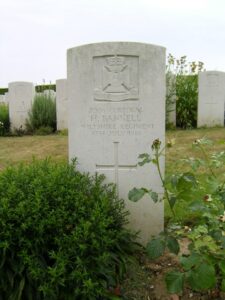
George Evans, Petty Officer, 206834, Royal Navy. George was born in Bosherston on 22 February 1883, the son of John and Elizabeth Evans. He married Alice Rose Davies in 1912 and the couple set up home at 93, Gwyther Street, Pembroke Dock. George had enlisted into the Royal Navy on 2 February 1901 and was a long serving seaman, having served on many ships during the coming years. On 2 June 1915 he was posted aboard the destroyer HMS Tipperary, which led the 4th Destroyer Flotilla of the Grand Fleet, commanded by Sir John Jellicoe. On the afternoon of 31 May 1915, the German High Seas Fleet was sighted off the coast of Jutland, and was intercepted by the British Grand Fleet led by Jellicoe, which had steamed from its base at Scapa Flow. The battle began that afternoon and raged on overnight. The Tipperary sighted a line of battleships closing toward her at 12.03 a.m. on the night of 31 May – 1 June, and flashed a recognition signal at them. Unfortunately, the ships were the German Battleships ‘Westfalen’, ‘Nasau’ and ‘Rhineland’, accompanied by the German light cruisers ‘Stuttgart’ and ‘Hamburg’. The ‘Westfalen’ opened fire, raking the Tipperary with over 100 rounds of high explosive shells, and within minutes the Tipperary became a blazing wreck. The fuel and ammunition on board her soon caught alight, finally sinking at around 2.00 a.m. on the morning of 1 June 1915. Of the 197 crew members aboard her, 185 were dead, one of these being George. The 33-year-old has no known grave but the sea, so is commemorated on the Portsmouth Naval Memorial, Hampshire. George is commemorated on a stained glass window in the church, which had been installed at the behest of his widow in 1916 and was unveiled by the Superintendent of Pembroke Dock, Captain Gilpin Brown.
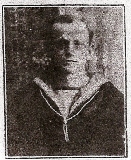
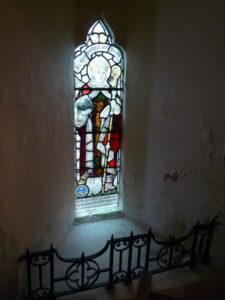
Griff Evans, Sergeant, 87042, Welsh Regiment. Griff was born on 2 February 1890, the son of George and Jemima Evans, of Pen y Wen, Stackpole. He left home as a young man as by 1911 was lodging together with his brothers, Richard and William John Evans, at 94, King Edward Street, Blaengarw, where they worked as coal hewers. Griff had originally enlisted into the 9th Battalion, Welsh Regiment soon after the outbreak of war and served on the Western Front from the summer of 1916 onwards. Following the Armistice, he re-enlisted and joined the 1st Battalion, Welsh Regiment. The battalion had served during the war with 84 Brigade, 28th Division, and had seen action on the Western Front, before moving to Salonika in 1915. After the war, the battalion returned to Cardiff, before embarking for India. George became ill and died of syncope at Ferozepore, India on 10 December 1919. The 28-year-old was buried in Ferozepore Military Cemetery, India. He has until recently been commemorated on the Kirkee 1914-1918 Memorial, India. Griff is not commemorated on the Bosherston Memorial, although his brother William John Evans is.
James William Evans, Private, 143031, Machine Gun Corps. James was born in 1882, the son of Thomas and Alice Evans, of Kent House, Bosherston. He originally enlisted at Pembroke into the Welsh Regiment with the Army Number 15547, but then transferred into the South Lancashire Regiment, together with his brother Thomas, and served on the Western Front. James must have been invalided home sick or wounded at some time, as he was then posted to the R.D. Company, Machine Gun Corps. James became ill and died of sickness at the Welsh Hospital, Whitchurch, Cardiff on 22 October 1918, aged 36. His body was brought home and he was buried with full military honours in St. Michael’s Churchyard, Bosherston on 1 November. His brother, Thomas Henry Evans, had died in France three months earlier.
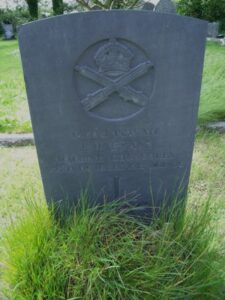
Thomas Henry Evans, Private, 3403, South Lancashire Regiment. Thomas was the son of Thomas and Alice Evans, of Kent House, Bosherston. He enlisted at Pembroke into the Welsh Regiment, and after completing his training was drafted to France, joining the 1st/5th Battalion, South Lancashire Regiment, which was attached to 166 Brigade, 55th (South Lancs) Division. The Division had fought at the Somme in 1916, and at Passchendaele and Cambrai in 1917 before wintering in the Givenchy and Festubert sector. On 9 April 1918 the relative peace of this sector was smashed when the German Spring offensive swept upon them. The Division bravely held out, gaining a well-deserved reputation for its fighting qualities, prompting the siting of the Divisional Memorial at Givenchy after the war. The division stayed in the same area until late August 1918 when the great advance began. Thomas was fatally wounded during a routine spell in the line in the summer of 1918 and died of his wounds on 20 July 1918. The 22-year-old is buried in Pernes British Cemetery, France, in Grave V. F. 13. His brother, James William Evans, died in hospital in Cardiff just three months later.
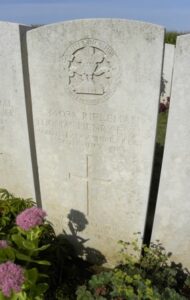
William John Evans, Private, 28106, Welsh Regiment. Williamwas born on 26 June 1885, the son of George and Jemima Evans, of Pen y Wen, Stackpole. He left home as a young man as by 1911 was lodging together with his brothers, Richard and Griff Evans, at 94, King Edward Street, Blaengarw, where they worked as coal hewers. William enlisted at Bridgend into the 18th Battalion, Welsh Regiment soon after the outbreak of war. The battalion was attached to 119 Brigade, 40th (Bantam) Division, which had been formed from men who would have originally been too short for regular army service, before the needs of war necessitated a reduction in standards for their intake. The Division moved to France between 1 and 9 June 1916, moving to Loos, but was sent to the Somme in late 1916, taking part in the Battle of the Ancre. The division followed the German retreat to the Hindenburg Line in March 1917, and also played a big part in the Battle of Cambrai in the Winter of 1917, attacking Bourlon Wood. On 21 March 1918 the Division was caught up in the German Offensive and fought at the Battle of St. Quentin and the First Battle of Bapaume, before moving north to Flanders to rest and rebuild. Unfortunately, the Germans switched their attention to the Lys Valley on 9 April and the 40th Division was plunged into desperate fighting once again. William was killed in action during the Battle of Hazebrouck on 13 April 1918. The 33-year-old has no known grave and is commemorated on the Ploegsteert Memorial, Belgium. His brother Griff died on active service in India in 1919.
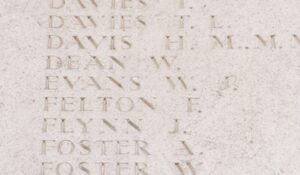
Frank Rogers MM, Lance Corporal 26388, Welsh Regiment. Frank was born in 1888, the son of John Rogers and Elizabeth Rogers (nee Griffiths), of Bosherston Post Office. He left home as a young man and by 1911 was lodging at 4, Alstred Street, Pembrey, where he worked as a coal miner, but by the time war erupted, was residing at Ammanford. Frank enlisted at Ammanford in April 1915 into the 17th Battalion, Welsh Regiment. The battalion was raised in January 1915 as a Bantam Battalion, made up of men of below average height, and initially went to Porthcawl attached to the 43rd (Welsh) Division. During July 1915 the battalion moved to Prees Heath to join 119 Brigade, 40th (Bantam) Division and landed in France with the Division in June 1916. The Division moved to positions around Lillers before taking over the North Maroc Sector, near Loos, for trench initiation and once acclimatised was left to hold the sector itself over the coming months. The infantry battalions of the Division then began the usual routines of rotating for duty in the trenches: normally four days in the front line; four in support and four in reserve. Late in 1916 the Division moved south to the Somme, and fought at the Battle of the Ancre, before remaining in the sector over the winter. In March 1917 the Germans withdrew to their shortened line, called the Hindenburg Line, and the 40th Division was among the units which followed the withdrawal. Frank gained the award of the Military Medal here on 29 July 1917, after creeping out into No Man’s Land, where he stalked and captured a German sniper. Later in the year the Division took part in the Battle of Cambrai and launched an attack on Bourlon Wood on 23 November 1917. The attack was carried out by 119 Brigade, led by the 12th SWB and 19th RWF. The 17th Welsh was in support for the initial assault, but was soon ordered to advance, to support the two attacking battalions. Heavy fighting raged within the wood over the coming days, with the 18th Welsh also being thrown forwards into the fight, and the Division suffered terribly. Frank was killed in action in Bourlon Wood on 25 November 1917. The 29-year-old has no known grave and is commemorated on the Cambrai Memorial, Louverval, France.
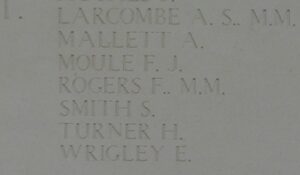
Thomas George Stephens, Private, 53659, Welsh Regiment. Thomas was born in 1892, the son of Thomas Stephens and Martha Florence Stephens, of Little Newton, Bosherston. He enlisted at Llanelli into the Pembroke Yeomanry, but after completing his training was drafted to France in the summer of 1916, joining the 2nd Battalion, Welsh Regiment. The battalion was on the Somme, attached to 3 Brigade, 1st Division and Thomas probably joined among a large batch of recruits following its heavy losses at Bazentin Ridge. The division saw further heavy fighting on the Somme during the Battle of Pozieres, before taking part in the Battles of Flers-Courcelette and Morval. The division wintered on the Somme and followed the German retreat to the Hindenburg Line in early 1917 before being briefed for an operation on the Flanders Coast, moving to positions near Coxyde during the summer of 1917. While the Division was holding the line near Coxyde, the Passchendaele offensive was launched on 31 July 1917, but had got bogged down, so at the beginning of November the Division was transferred to Ypres, to join the great push for Passchendaele Ridge. The Division took up positions near Valour Farm, on the lower edge of the ridge, by 9 November and prepared to launch an assault on the following morning. Thomas was killed in action here whilst the 2nd Welsh was moving into position on 9 November 1917. The 25-year-old has no known grave and is commemorated on the Tyne Cot Memorial, Zonnebeke, on Panel 93 to 94.
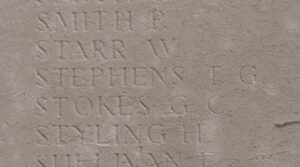
World War Two, 1939-1945
An engraved brass plaque inside the Church reads; “To The Glory Of God and In Memory of Richard Warlow Howells Killed in the Execution of His Duties as a Coastguard, by a Mine on Broadhaven Beach Saturday 9th January 1943.”
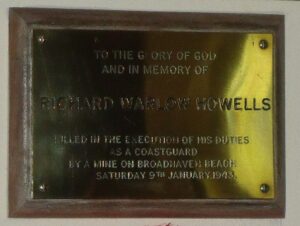
World War Two Scroll
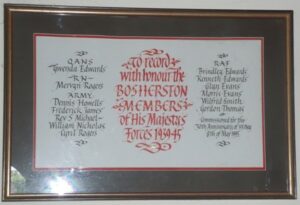
Also inside the Church is a framed scroll, which commemorates the members of the Parish who served during World War Two. The scroll lists the following names;
Gwenda Edwards, Q.A.N.S.
Mervyn Rogers, R.N.
Dennis Howells, ARMY.
Frederick James, ARMY
Rev S. Michael, ARMY
William Nicholas, ARMY
Cyril Rogers, ARMY
Brindley Edwards, R.A.F.
Kenneth Edwards, R.A.F.
Glyn Evans, R.A.F.
Morris Evans, R.A.F.
Wilfred Smith,R.A.F.
Gordon Thomas, R.A.F.
In addition, but not listed on the scroll was the single casualty of the area to have lost his life during World War Two.
William Joseph Canton, Private, 5111738, Royal Warwickshire Regiment. William was the son of John Henry Canton and Lilian Canton (nee Gwyther), of Stackpole. He enlisted into the army and served with the 1/7th Battalion, The Royal Warwickshire Regiment, a Territorial Army unit which had fought in France during the retreat to Dunkirk in 1940. Members of the Battalion were infamously murdered by the S.S. after their surrender. After the Normandy Landings of 6 June 1944, the 1/7th Warwicks landed at Queen Beach on 29 June. The first engagement for the 1/7th was on 8 July 1944, to capture the village of St Contest. It was a hard fought battle as they were up against the first-rate 25th SS Panzer Grenadiers. Even so by 6.30pm they had reached their objective having lost 26 men and 96 wounded. William was killed just days later, on 17 July 1944. He was 26 years old, and is commemorated on the Bayeux Memorial, France. William is also commemorated on the War Memorial at Stackpole Elidor.
